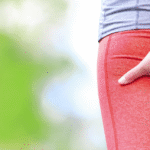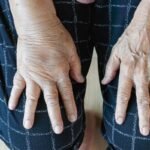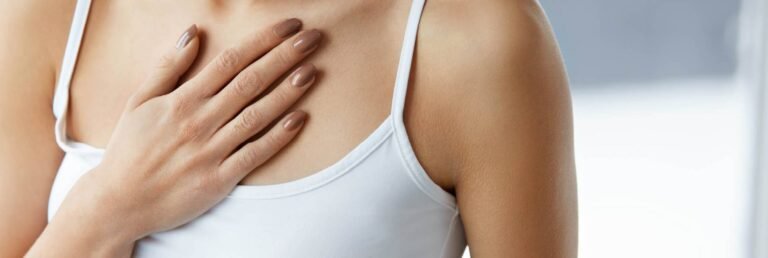Vaginal dryness during menopause is a very common problem starting at age 50. It’s estimated that 40% of women experience it by this time.
This vaginal dryness associated with menopause is a consequence of the atrophy that this part of the body experiences at the end of fertile life and is usually accompanied by other symptoms.
These include vulvovaginitis (irritation, burning, or itching of the vulva and/or vagina), decreased lubrication and pain during sexual intercourse, postcoital bleeding, decreased arousal, orgasm, and desire, and increased urination frequency.
This genital atrophy is progressive, and the first symptoms may appear during perimenopause. Thus, some women begin to experience discomfort such as vaginal dryness after their forties.
However, it is especially with the arrival of menopause that dryness and other symptoms of vaginal and vulvar atrophy intensify.
This is due to the cessation of ovarian function activity and, therefore, to the decrease in estrogen production in the ovaries.
As a result, the vaginal wall becomes thinner and loses elasticity, the vaginal flora changes and the pH becomes alkaline, and the vaginal glands contract, reducing vaginal lubrication.
This feeling of vaginal dryness during menopause can also be exacerbated by taking medications for conditions whose incidence increases with age or whose risk is increased at this stage of a woman’s life.
For example, tricyclic antidepressants for sleep disorders or insomnia and depression, anticholinergics for the treatment of gastrointestinal disorders, or certain antihypertensives.
At the same time, diabetes can also affect a lack of vaginal lubrication, especially if blood glucose control is poor.
The cessation of estrogen production that occurs in all women means that vaginal dryness cannot be completely avoided during menopause.
However, various measures can alleviate this symptom of genital atrophy and minimize its impact on a woman’s quality of life.
How to improve vaginal dryness
1. Make lifestyle changes. Vulvar and vaginal pain and dryness can improve by changing certain habits. Smoking is a risk factor for female genital atrophy. This is because tobacco affects blood circulation and reduces the effects of natural estrogens in the body. Thus, quitting smoking is a measure to relieve vaginal dryness during menopause. A similar effect is associated with alcohol and marijuana use. Obesity, associated with poor physical activity, is also linked to a higher risk of genitourinary discomfort.
Thus, maintaining a healthy weight and avoiding a sedentary lifestyle would contribute to improving the lack of natural lubrication .
Another factor that can worsen vaginal dryness during menopause is stress. Increased cortisol levels in the blood cause an imbalance in the secretion of sex hormones, including estrogen, which can affect vaginal hydration.
Although we cannot speak of foods that help improve vaginal lubrication, metabolic disorders derived from an unhealthy diet have indeed been associated with alterations in genitourinary vascularization and, therefore, with a greater risk of vaginal atrophy.
Therefore, maintaining a healthy diet can be a preventative measure for female intimate dryness.
Another factor that may have a protective effect against vaginal dryness problems would be sexual activity, since a clear relationship has been observed between the prevalence of vulvovaginal atrophy and sexual dysfunction.
Thus, activity through intercourse would promote elasticity, vascularization and vaginal lubrication.
In this regard, it’s worth mentioning that a woman’s fears about sexuality can also trigger negative reactions to the lubrication process through stimulation of the nervous system, as well as a lack of interest in sex or a partner.
2. Maintain intimate hygiene. A common cause of vaginal dryness at different stages of a woman’s life is excessive genital hygiene or using harsh soaps.
When intimate hygiene is inadequate, the vulvovaginal mucosa is irritated and the microbiota is altered, worsening problems of atrophy and dryness.
To prevent this, use warm water and a soap specific to the pH of this area and limit hygiene to the external genitals.
Next, dry the area carefully, without rubbing with the towel.
You should also avoid underwear made of nylon or other synthetic fibers, tight-fitting pants, scented or plastic-coated pads, deodorant sprays, vaginal douches, and talcum powder for the genital area.
3. Use moisturizing and lubricating gels. Some moisturizing creams and gels act as lubricants and, therefore, combat vaginal dryness. This is possible by achieving a function similar to that of a woman’s cervical mucus.
These types of products cause changes in the fluid content of the vaginal epithelium, but they don’t contain hormones. In other words, they are estrogen-free lubricating creams.
They provide substances that are capable of accumulating water so that it can be released slowly.
In this way, in addition to improving vaginal dryness, they also reduce itching, burning, and pain during sexual intercourse.
One of the most widely used and effective active ingredients as a lubricant for women going through menopause is hyaluronic acid.
Hyaluronic acid also has regenerative properties, facilitating cell migration during inflammation and tissue repair. This helps preserve the integrity of the mucosa.
For these feminine moisturizers and lubricants to be effective during menopause, they should be applied to the vagina one or more times a week.
They can also be used during sexual intercourse to reduce irritation caused by mucosal friction.
Vaginal moisturizing gels and lubricants are the first line of treatment for vaginal dryness with mild or moderate symptoms.
Lifestyle changes, good intimate hygiene habits, and the use of moisturizing gels and lubricants are the main measures to relieve vaginal dryness.
4. Turning to pharmacological treatments. Estrogen-based hormonal pharmacological treatments have proven effective in improving vaginal dryness during menopause and other symptoms of genital atrophy.
However, unlike lubricating creams for menopause, these treatments are not free of side effects, especially in the case of systemic estrogens. Therefore, these drugs are only used in cases of moderate to severe vaginal dryness and atrophy.
Local estrogens can be presented in creams, ovules, tablets or vaginal rings.
These drugs provide significant improvement in 80-90% of women after 3 to 6 weeks of treatment. Furthermore, their use can be continued long-term, as long as the benefits are maintained.
Estrogen-containing lubricating creams are generally well tolerated and have minimal systemic absorption. However, some women may experience side effects such as breast tenderness or pain, nausea, irritability, or dizziness, among others.
Regarding systemic hormonal treatments, their use is usually limited to those women who not only have vaginal dryness, but also other urogenital symptoms and/or other limiting discomforts such as moderate or severe hot flashes.
Other medications for vaginal dryness that may be prescribed include ospemifene (a selective estrogen receptor modulator) or vaginal dehydroepiandrosterone (DHEA).
5. Combine with complementary treatments. Treatment for vaginal dryness during menopause can be complemented with more recent techniques such as hyaluronic acid injections, laser, or radiofrequency.
Submucosal injections into the outer third of the vagina have been shown to provide hydration, stimulate the extracellular matrix, and tone tissues.
In turn, hyaluronic acid injections into the vulvar lips appear to increase lip volume and reduce the sensation of friction during intercourse.
Regarding laser therapy, it stands out for being a noninvasive technique with few side effects and rapid results. Fractional CO2 laser and erbium laser are commonly used to treat vaginal dryness during menopause.
The available evidence indicates that both technologies successfully improve genital atrophy and vaginal hypermobility, with or without urinary incontinence. As a result, they alleviate discomfort caused by vaginal dryness, as well as pain during sexual intercourse.
Finally, radiofrequency appears to improve vulvovaginal laxity by producing changes in the collagen and elastin structure. However, the available evidence for this technique is still limited.
Regarding herbal remedies for treating vaginal dryness during menopause (e.g., borage and evening primrose oil, don quai, or green tea, among many others), there are insufficient studies to support their recommendation.
Regarding soy isoflavones, the evidence is controversial, while home remedies for vaginal dryness such as using petroleum jelly or coconut oil should be avoided.
It’s important to note that you should consult a gynecologist if you experience this symptom or other discomfort associated with genital atrophy. This will allow for an accurate diagnosis and the most appropriate treatment for each case.




















+ There are no comments
Add yours